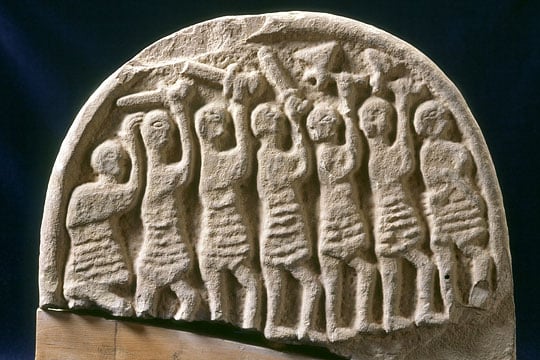Significance of Lindisfarne Priory
Lindisfarne was one of the most important places in Anglo-Saxon England. Its bishops had close links to the Northumbrian kings who ruled from nearby Bamburgh. The monks’ guardianship of the shrine of St Cuthbert brought great wealth to the monastery. The architecture of the 12th-century priory founded on the site of the earlier monastery resembled the great Romanesque cathedral at Durham, visually reinforcing the connection between cathedral and monastery.

Anglo-Saxon Monastery
Mission Centre
The monastery founded here in 635 became the base for the conversion of the northern kingdoms of the Anglo-Saxons from paganism to Christianity, and one of the most important cultural centres of its age.
St Cuthbert
The cult that developed around the relics of St Cuthbert, bishop of Lindisfarne from 685 to 687, secured the long-term prosperity of the community. Cuthbert’s fame was spread by the stories written down by the Anglo-Saxon scholar the Venerable Bede (673–735). St Cuthbert became one of the most popular saints in Britain before the Reformation.
Lindisfarne Gospels
The Lindisfarne Gospels were made here in the early 8th century, when the monks were beginning in earnest to promote the cult of St Cuthbert. It is one of the most beautiful and intricate manuscripts ever produced, and shows that this period was anything but a ‘dark age’. The Lindisfarne Gospels assimilate the spiritual and cultural influences of Ireland, Rome and the Germanic world of the Anglo-Saxons.
Stone Sculpture
Excavations at the priory have produced a remarkable collection of 51 complete or fragmentary Anglo-Saxon carved stones.[1] Many are on display in the site museum.
Some of these are grave markers, carrying the name of a man or woman. The names are written in capital letters, like those found in the Lindisfarne Gospels, and some are written in runes.[2] The survival of the fine carving implies that these grave markers were buried below ground, rather than exposed to the elements. Similar grave markers have been found at the sites of Anglo-Saxon monasteries in Hartlepool and Whitby.
The sculptures show that the cemetery was still in use in the 10th century, suggesting that a Christian community remained there after the monks had left. A remarkable 9th-century stone sculpture (see above) clearly shows a violent attack by armed men, brandishing Viking-style swords and battle axes.[3]
Medieval Lindisfarne
Links with Durham
The church built on the site of the Anglo-Saxon monastery in the early 12th century is a miniature version of Durham Cathedral, constructed in the late 11th century. The resemblance was deliberate, making a visual connection between Durham, where Cuthbert’s body had come to rest, and Lindisfarne, where he had lived and died. A cenotaph (empty tomb) on the site of the old shrine provided a focus for medieval pilgrims.
Unusually, the church at Lindisfarne was completed before the monastic buildings. This is the reverse of the normal building sequence in a monastery, and the priority accorded to the church highlights its importance to the religious community at Durham that sponsored the refoundation at Lindisfarne.
Defences
The priory church was later fortified in response to the wars between England and Scotland in the 14th century. Many features survive that are more commonly seen in medieval castles, including a defended gateway, a most unusual feature in a monastery.
More fortifications were built after the priory’s suppression in 1537 to protect the harbour. The small fort at the east end of the Heugh is a rare survival of its type and size, unmodified by later reconstructions. Its importance thus belies its unprepossessing appearance.
Documentary Evidence
Detailed accounts and inventories survive from 1326 until the 1530s, revealing a great deal about the regular life of the monastery and how it changed over time.[4] They show how the community responded to the national threat caused by the wars between England and Scotland, and document the connections between Durham and Lindisfarne.
READ MORE ABOUT LINDISFARNE PRIORY
Footnotes
1. Most of the sculptures were excavated in the early 20th century, and the context of their discovery was poorly recorded.
2. An alphabet sometimes used for vernacular (Old English) texts.
3. See also R Cramp (ed), Corpus of Anglo-Saxon Stone Sculpture, vol 1: County Durham and Northumberland (Oxford, 1977), no. 37 (accessed 15 May 2013).
4. These are all published in J Raine, The History and Antiquities of North Durham … (London, 1852).
